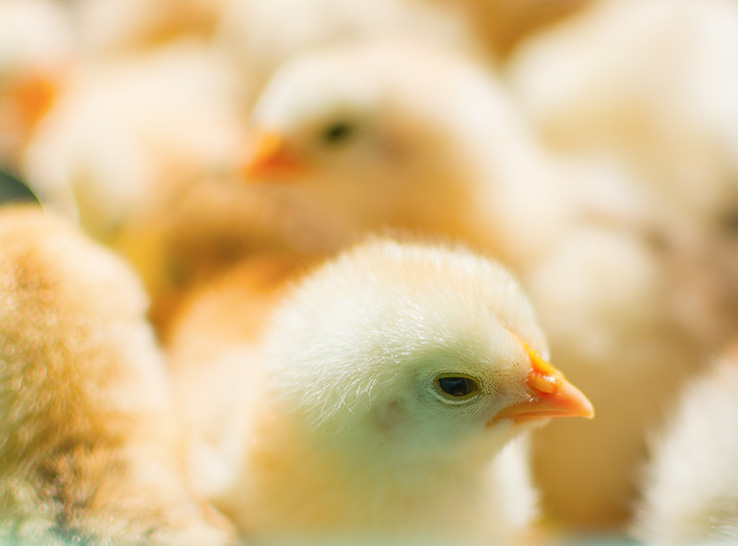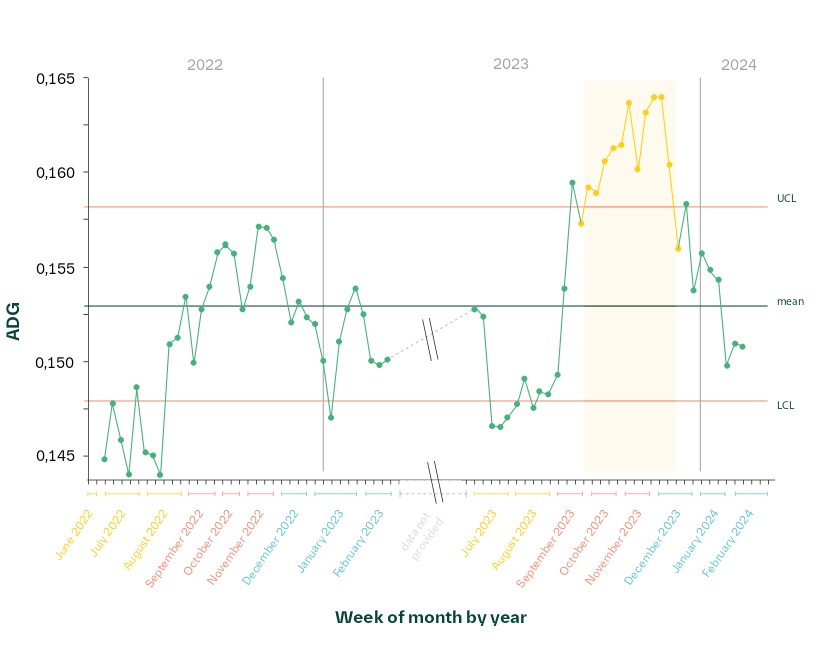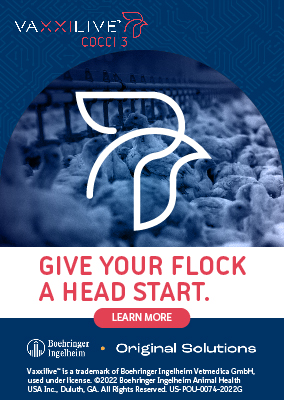An innovative vaccine designed to protect broilers against increasingly virulent forms of Marek’s Disease is helping producers rethink how they approach immune health, and how they use data to diagnose problems before they’re visible in the flock.
For decades, Marek’s Disease Virus (MDV) has been recognized by the presence of tumors in birds’ nerves and organs. But in recent years the disease has evolved to more virulent forms — known as very virulent plus (vv+) — that cause damage that is harder to spot.
These very virulent strains primarily attack the bursa of Fabricius and thymus of developing chicks, which are critical centers for birds’ immune development.
As a result, flocks might appear clinically normal, but will struggle with performance and be at risk of secondary diseases.
“Producers often say, ‘I don’t have a Marek’s problem, I’m not seeing tumors’,” said Sierra Slautterback, DVM, key account veterinarian at Boehringer Ingelheim.
“But we’ve gone from being able to spot obvious clinical signs to a situation where it’s causing deep immunosuppression without those traditional visible signs. It means we need to retrain ourselves to recognize what Marek’s looks like today.”
For Slautterback, recognizing signs of the disease requires new tools, both in the forms of prevention and diagnosis.
“Data is critical to diagnosing if there’s a Marek’s issue,” she said. “We’re trying to get producers to look at performance dips, increased secondary diseases or poor vaccine takes and ask themselves if it could actually be Marek’s just in a form they’re not used to recognizing?
“Collecting data and really making use of the information is key to understanding what challenges you’re facing.”
Tackling the challenge
In terms of prevention, the evolving challenge of MDV has prompted the development of more sophisticated solutions, such as PREVEXXION® RN from Boehringer Ingelheim – the only chimeric vaccine currently available in poultry.
Designed specifically to address the limitations of older vaccines like SB-1 and Rispens (a widely used serotype 1 vaccine base), which are increasingly ineffective against today’s virulent MDV strains, the chimeric vaccine incorporates three genetic components of the virus into a single serotype 1 vaccine: CVI988/Rispens, a virulent (v) strain and a very virulent (vv) strain.
Together, they offer broader and more robust protection, allowing the vaccine to mimic the threat birds are most likely to face in modern production systems without triggering immunopathology or vaccine-induced tumors.
“It’s still a monovalent Marek’s vaccine, not three viruses in one,” Slautterback explained. “But we’ve designed it with components that help the bird’s immune system recognize and fight the full range of Marek’s virulence in the field.”
To demonstrate the value of PREVEXXION® under commercial conditions, Boehringer Ingelheim collaborated with a large-scale broiler operation producing about 1.5 million birds per week.
For 13 weeks, all flocks in the complex received PREVEXXION® in ovo at 18 days of incubation, replacing the SB-1 vaccine previously used. No other changes were made to the production system, and both vaccine protocols contained an HVT + IBD application in ovo.
Crucially, the project was designed not just to observe clinical signs, but also to gather meaningful data.
“We took a multi-layered approach,” said Slautterback. “We looked at immune organ health, using histopathology of the bursa and thymus, and we paired that with production plant data over more than a year — both before and after the project, to get a much richer picture of what was really going on.”
The histopathology involved analyzing the condition of immune organs in flocks before, during and after the vaccine change. This allowed the team to quantify immune suppression at a cellular level, identifying unseen damage that wouldn’t show up in live birds or routine post-mortems.
At the same time, the analysts used Statistical Process Control (SPC) methods to track feed conversion ratio (FCR) and average daily gain (ADG) from the processing plant. These metrics were charted across seasons to account for expected seasonal fluctuations due to ventilation, temperature or feed changes.
Immediate results
Slautterback said the results showed the vaccine had an immediate impact on the birds, with flocks vaccinated with PREVEXXION® showing significantly improved immune organ health, with less histological damage in the bursa and the thymus.
The birds also achieved better feed efficiency and growth, not just during the project, but compared to the same period in the previous year.
There was also no increase in leukosis or other tumor-related rejections, affirming vaccine safety even with virulent components included.
“The ADG and FCR improvements were the best the complex had seen,” Slautterback said.
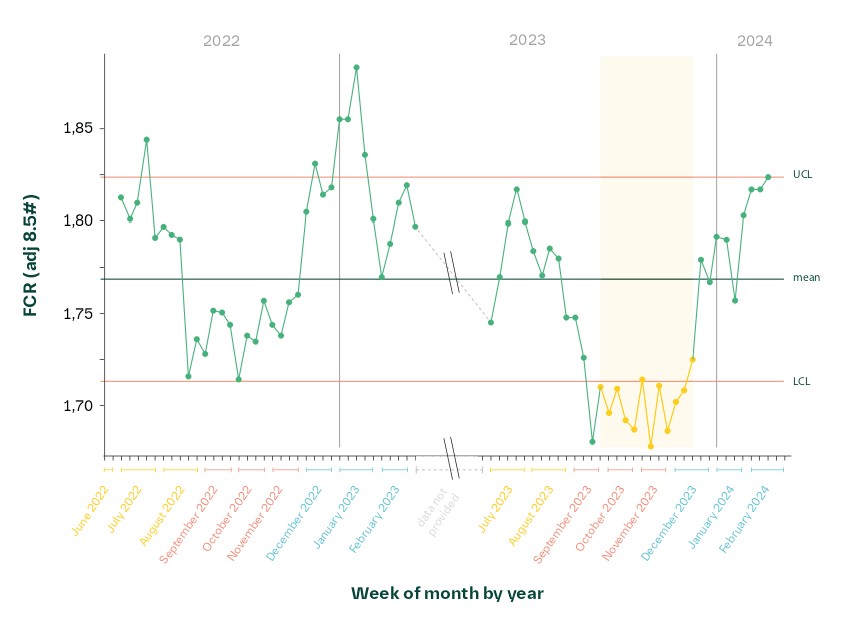
Figure 1. Weekly FCR adjusted to 8.5 pounds (10:1) from June 2022 through February 2024 (data not provided March-June 2023). Shaded area highlights a significant systematic change (data maintained outside of 3 standard deviations from the mean) even greater than the previous fall data.†
Figure 2. Weekly ADG from June 2022 through February 2024 (data not provided, March-June 2023). Shaded area highlights a significant systematic change (data maintained outside of 3 standard deviations from the mean) even greater than the previous fall data. †
†Corresponding SPC Range charts (difference between the high and low values at each time point) demonstrated normal variation indicating the process was in control and analyzable by SPC throughout data collection time frame (data not included)
Just as telling was what happened after the project ended, she added. When the complex reverted back to its original vaccine protocol, histopathology scores worsened, suggesting the benefits were not only real but quickly lost when protection was reduced.
Despite clear improvements, Slautterback said the birds didn’t show visible behavioral changes during the project. This reinforced the value of relying on data rather than field-level visual clues alone.
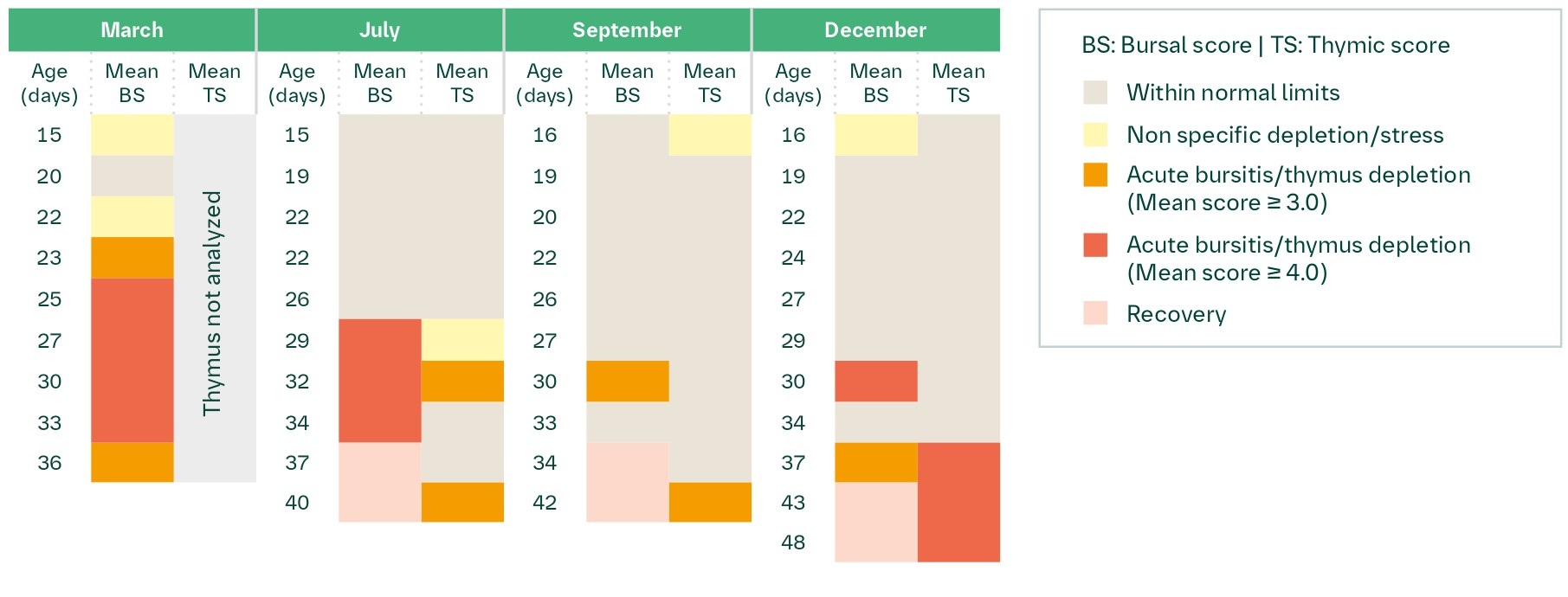
Figure 3. 2023 Quarterly Immune Health Survey results (thymic analysis absent, March). Note severity and duration of acute histopathology in March, July and December when flocks were vaccinated with SB-1. All flocks in September were vaccinated with PREVEXXION®.
NB: Some duplicate age flocks were removed if results were identical, for ease of visualization.
“The birds looked fine,” she said. “That’s why data is so important. You might think everything is okay, but when you look at what’s going on at the immune level, and what that’s doing to performance, it’s a different story.”
The value of data
For Slautterback, the project results show the importance of tracking performance so that producers can take action before visible signs of damage appear.
“Producers are dealing with all kinds of issues — avian influenza, necrotic enteritis, respiratory disease and feed cost volatility — so it’s easy to overlook immune suppression because you can’t see it.
“Signs of Marek’s might not be obvious, but it’s still a primary immunosuppressive disease, and it should always be on the radar.
“We should be asking if our vaccination programs are truly giving birds the best possible foundation to succeed. Because if the immune system isn’t working, nothing else will.”
In the case of the farm involved in the project, the results were enough to convince the producer to roll PREVEXXION® out across other complexes, especially in areas with higher challenge levels.
“They were open to trying it, but the data convinced them,” Slautterback said. “The results speak for themselves.”
For producers still unsure whether Marek’s is impacting their flocks, her advice is simple: “Ask yourself, how do you know if you’re not looking?
“You’ve got the data — the plant records, post-mortems and production metrics — so use it. Marek’s is still with us, and it’s changing. So we have to change how we look for it and tackle it.”
Editor’s note: Content on Modern Poultry’s Industry Insights pages is provided and/or commissioned by our sponsors, who assume full responsibility for its accuracy and compliance.

